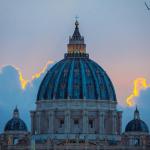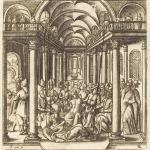ST. FRANCIS XAVIER’S COLLEGE: Twelfth Commencement.
The New College Building.
The Graduating Class.
Prosperity of the College.
The New York Times, July 8, 1862
The Twelfth Annual Commencement of St. Francis Xavier’s College in this City took place yesterday afternoon, in the vast new hall of the college just erected in the college grounds, between Fifth and Sixth avenues, Fifteenth and Sixteenth streets. The building is divided into spacious class-rooms in the two lower stories. The entire upper floor, measuring about 60 feet by 120, is, thrown into a chapel. The high walls and ceilings are tastefully frescoed, with here and there an appropriate Catholic device.
The organ loft is spacious and tasteful, and will be filled with one of the finest organs in the United States. The room is excellently lit, either with daylight or gas, and is finely ventilated, with massive windows leading nearly from the floor to the ceiling. The stage is arranged, somewhat on the plan of the Cooper Institute, but, fortunately, the view is unobstructed with any of those odious pillars that are always sure to be in the way when you wish to see the speaker’s face. There are seats for about 1,200, and, with a little crowding, 1,500 or 2,000 may be accommodated. The cost of the edifice was about $50,000.
The exercises yesterday attracted an overflowing house, comprising allarge representation of our most prominent citizens, representatives of educational institutions; the Catholic clergy, and the lady friends of the Institution — whose name is legion. The students occupied the platform in full view. The exercises consisted of the following order:
Overture: “Martha,” Flotow
Discourse: “Excellence of Labor”. Mr. Chas. J. Duane
Cantata: Composed for the occasion…..Wm. Berge
Discourse: “Utility of Classics,” Mr. James T. Barry
Bensel Quickstep (Military Band), ……Wm. Berge
Discourse: “Political Liberty”.. Mr. Thos. P. Dolan
Ave Maria: “Lurline,” Wallace
Discourse: “Spirit of the Age,” Mr. Thos. A. Phelan
Pleasure Lancers (Orchestra), C. Berge
Discourse: “Principle in Character,” Mr. Edward F. McSweeny
Hunting Chorus: “Lurline,” Wallace
Discourse: “Catholicity and Intellectual Development,” Mr. Bernard H. Kernan
Music (Orchestra)
Address to the Graduates, Rev. Thos. Killeen, A.M.
Pio. IX (Cantata): Baccilieri
The efforts of Masters PHELAN, MCSWEENY and KERNAN were particularly commendable. The following were the degrees conferred:
The Degree of LL. D. on John G. Shea, New-York.
The Degree of A.M. on
Francis A. Engelhardt, Gottingen, Hanover
Winand Wigger, New York
The Degree of A.B. on
James T. Barry, New York
John A. Brophy, New York
William A. Cunningham, New York
Thomas P. Dolan, New York
Charles J. Duane, Ulster County, New York
John Edwards, County Clare, Ireland
Patrick Gleason, County Galway, Ireland
Bernard P. Kernan, New Orleans, Louisiana
Francis W. Lamb, New York
William F. McCarthy, New York
William J. McNab, New York
Edward F. McSweeny, Cork, Ireland
George C. Murphy, New York
Thomas A. Phelan, New York
Charles Reilly, County Cavan, Ireland.
Among about 650 pupils there were of course many premiums to be distributed. We have space for but the leading ones, who received first premiums, as follows:
Good Conduct, University Course: John Fitzsimmons.
Classical Course: Joseph F. Mosher.
Preparatory Course: Leon Harvier.
Religious Instruction, Rhetoric: Wm. J. O’Neil.
Belles Lettres: Eugene B. Murtha.
Classics: Edward A. O’Connor.
First Grammar Class: Charles S. Quinn
Second Grammar Class: John F. O’Reilly
Third Grammar Class: James T. Murphy, Robert J. Nixon.
Commercial Course, First Class: Jas. J. Smith
Second Class: James J. Phelan
Preparatory Course, First Class: Henry D. Casey
Second Class: George Dority
Third Class: George Morgan
Application: Rhetoric: Wm. McCloskey
Belles Lettres: Wm. O’B. Pardow, Patrick A. Halpin.
Classics: Michael Nevin.
First Grammar Class: Thos. J. Campbell, James T. Casey
Second Grammar Class: Thos. F. J. McCarthy
Third Grammar Class: Edward Martin, Michael Madigan.
Commercial Course, First Class: Wm. L. Bennett;
Second Class: Thomas Geraghty.
Preparatory Course, First Class: Leon Harvier, Charles Dority;
Second Class: Henry Kovermann;
Third Class: Charles Gibbons.
Classical Instruction, Rhetoric: Thos. W. Kilduff.
Latin Discourse, Latin Poetry and English Discourse: John T. Goodwin.
Greek Exercise and Trigonometry: Wm. McCloskey
French: John F. Tierney.
History: John A. Dixon.
Belles Lettres Proficiency: Eugene B. Murtha.
Latin Composition: Bernard Kelly.
Latin Verse: Ferdinand C. Johnston.
Greek Exercise: Eugene B. Murtha.
English Composition: Wm. J. Lane.
French: Wm. S. Healy.
History and Geometry: Eugene B. Murtha.
Classics Proficiency: Michael Nevin.
Latin Composition: Peter J. Kelaghan.
Latin Verse: Ed. A. O’Connor.
Greek Exercise: Peter Kelaghan.
English Composition: Patrick Loughran.
French: Edwin J. McCahill.
History: Edward A. O’Connor.
Algebra: Michael Nevin.
In the first Grammar Class of this course, the names of John S. McNulty, Thos. J. Campbell, Thos. Swanton, Arthur S. McCaffray, Jos. F. Mosher, Chas. S. Quinn. and Jas. T. Casey, are on the list for first premiums.
In the second Grammar Class similar honors are awarded to John T. O’Hara, Francis McCoy, Charles M. O’Keefe and Robert E. McCafferty — O’Keefe taking the lion’s share.
In the third Grammar Class the names of Peter Condon, James T. Murphy, Thomas Bannen, Peter V. Burtsell and Joseph Byron take first premiums in their different studies.
In the accessory branches first premiums are taken as follows:
Elocution: Wm. J. O’Neil, John S. McNulty.
German: Henry Brandis, Owen J. Cashin.
Penmanship: Simon J. Kilduff, Julius Herold.
Drawing Landscape: Henry Brandis.
Outlines and Shade: Patritius Rodrique, Leon Harvier.
Linear: Michael J. Kelly.
Figuring: Wm. F. Flannelly.
Vocal Music, Soprano: Patrick A. Halpin, Charles Dority;
Alto: Joseph S. Sullivan;
Tenor and Bass: Wm. J. O’Neil.
Prizes of Honor awarded for successful examination:
On all Sallust, to Edward A. O’Connor, of the Class of Classics.
On Caesar’s Commentaries to John E. Cahalan, James J. Murphy, Shepherd K. Mattison, Owen J. Cashin, and Charles S. McCann, of the Class of First Grammar.
On all Phoedrus, to Frank McCoy and Charles M. O’Keeffe, of the Class of Second Grammar.
Next in merit, and deserving an honorable mention:
John Healy, of the Class of First Grammar
John T. O’Hara and John Loughran, of the Class of Second Grammar.
The entire Institution is under the charge of Rev. J. Durthaller, S.J., President and Prefect of Studies, who is assisted by twenty tutors. The music, under Prof. W. Berge, is, without doubt, unequalled by any institution of the kind in the country, whose cantata, composed for the occasion and sung by the students, accompanied by an orchestra of forty performers, was a real master-piece. The reporters are indebted for facilities to Rev. Father L. Schneider, S.J., Professor of Rhetoric and Elocution.
NOTE
The institution known today as Xavier High School began in Manhattan in 1847 as the College of St. Francis Xavier. It was the second Jesuit school in the city, St. John’s College having been founded at Fordham in 1841. While Fordham took boarders, Xavier was strictly a “day-hop” school. It ceased to function as a college during the 1910’s. Its alumni include the nations’ leading educators, jurists, politicians, military men, and clergy. This newsclipping appears to have been the first of many New York Times articles that would feature Xavier.
In 1862, when the above commencement took place, the president was Father Joseph Durthaller, S.J. (1819-1885). Born in the Alsace-Lorraine region of France on the German border, he studied in Francebefore joining the Jesuits at age 25. He left France during the 1848 revolution and came to America.
Soon he was sent to Xavier, where he built a new building and developed the curriculum. He is considered Xavier’s “second founder.” In 1863, he left Xavier for Buffalo, where he founded a German parish and was active in the founding of Canisius College. From there he served as a pastor in New Jersey and Manhattan until his death in 1885.
The above list of names is an impressive one. John G. Shea was the first historian of Catholic America, writing a four volume history. Winand Wigger became a priest and the second Bishop of Newark, New Jersey. Many others went on to become leading figures in the city as attorneys, authors, educators and clergy. Two of the younger students, William O’Brien Pardow and Thomas J. Campbell, became prominent Jesuits. Both served as president of Xavier and Provincial for the New York Jesuits. Campbell also served as president of Fordham and wrote significant works on Jesuit history.

















